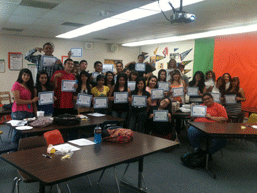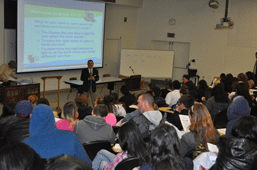Teaming Up with School Districts and Schools on a Financial Education Program: One Bank's Tips for Success
Educators who use the Money Smart program often contact Money Smart News to share information about their work or suggest someone who could be a good candidate for a success story. In this edition of our newsletter, we dig into our mailbag and shine the light on the work of one such partner -- Finance and Thrift Company, an FDIC-insured institution in Porterville, California -- that has not only used Money Smart but is willing to offer specific details on how to be successful in offering financial education programs in local schools. We hope that their suggestions can be helpful for other bankers and their community partners to consider in replicating similar initiatives.
Between 2009 and mid-2012, Finance and Thrift Company provided financial education to 2,949 students in local schools. One educational program was a Money Smart workshop held the last two years as part of the curriculum for the Academy of Business and Finance at Porterville High School. A total of 294 students participated. The bank also held a Money Smart session at nearby Bakersfield College in Bakersfield, California, at an annual one-day event to help students work toward college degrees. A total of 217 young adults – all either planning to attend community college or hoping to transfer from a community college to a four-year institution – attended. "This year we decided to add Money Smart training to our day-long event because of the importance of students managing their financial aid resources during college," said Sue Granger-Dickson, Bakersfield College's Transfer Center Coordinator. "Changes in federal financial aid make it more important than ever for students to manage their money wisely and complete their education in a timely manner."
What can bankers and other financial educators learn from Finance and Thrift Company about how to partner with local schools? The following summary is based on tips and information from Tom Zarate, Finance and Thrift’s Vice President and Director of Business Development as well as its Money Smart teacher, plus additional thoughts from Luke W. Reynolds, Acting Associate Director of the FDIC's Division of Depositor and Consumer Protection.
Get the support of senior management. Buy-in is needed to develop a long-term financial education initiative. Bob Hughes, the bank's President and Chief Executive Officer, said, "Our providing sound money-management skills to young people helps to ensure a bright financial future for the student. One of the many positive outcomes is their contribution to the economic outlook of the community where they choose to live as adults."
Be sensitive to educators' timelines. Restrictions may include mandated schedules under state or federal requirements and the class periods and days that may be available for financial education at a particular school. "Consider showing the school how Money Smart for Young Adults is aligned with state educational requirements; the alignment matrix is on the CD," said Reynolds. "You can show the educators at the school how sound money management and core academic subjects can be taught simultaneously, that it isn't always an either/or proposition."
Consider joining your school district's advisory board. "This will give you a better understanding of the school district’s short- and long-term goals and objectives that educators and school administrators are striving to attain," Zarate said. Reynolds added that "some school districts have several advisory boards, so reaching out to staff at one of the schools, perhaps an external affairs coordinator, can be a good way to learn more about how to start a long-term partnership with the school district."
Promote your financial education initiative. Advertise in local publications, appear on local television and radio shows, explore local speaking engagements, and meet with career-training agencies and non-profit organizations. Highlight statistics about the need for financial education in your community. Zarate speaks regularly to service groups, and private sector groups to promote the Money Smart program.
Be patient. "Some workshops require scheduling an entire year in advance in certain school and college districts," Zarate added. Use this downtime to develop collaborations within the community. Reynolds also said that the waiting period "can be a good time for the bank staff charged with promoting financial education to talk to the products staff to see what savings products can be offered to the students."
As for a good tip for conducting the classes, Zarate offered this: "Keep the students engaged throughout the learning process using real-life scenarios. It helps the students put things in perspective."
Efforts such as these have the potential to pay dividends. According to Michelle Halopoff, Career Technical Education teacher at Porterville High School, the Money Smart workshop there "teaches and encourages students to make sound financial decisions, prepares our young adults for financial independence, and teaches them how to minimize debt. Our students are better prepared to face the real world because they know how to manage their money."
Educators who want to read more about how to reach young adults are encouraged to review past success stories using the link below.

Students at Porterville High School's Academy of Business and Finance displayed their Money Smart certificates after completing training by Finance and Thrift Company.

Tom Zarate, Finance and Thrift's Vice President and Director of Business Development, led the one-day Money Smart workshop at Bakersfield College for young adults planning to attend community college or hoping to transfer from a community college to a four-year institution.

